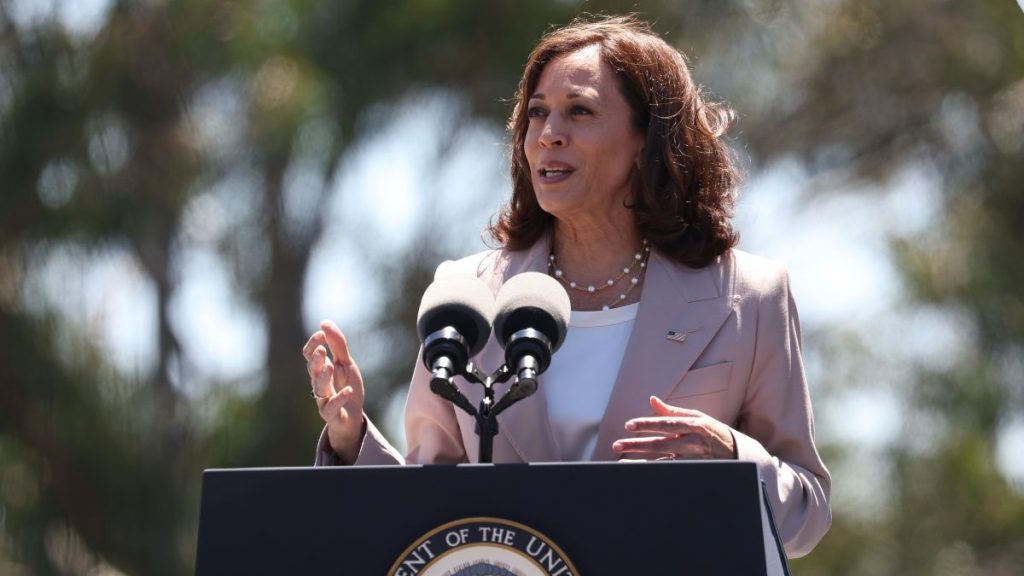
VP Kamala Harris to attend Artemis 1 moon launch (exclusive) (Image Credit: Space.com)
U.S. Vice President Kamala Harris is one of the VIP guests at NASA’s upcoming moon launch.
Harris will be on site to watch the Artemis 1 moon mission lift off Monday (Aug. 29) from NASA’s Kennedy Space Center (KSC) in Florida, Space.com learned in an exclusive update from the Vice President’s office.
While at KSC, Harris, who also chairs the National Space Council, will deliver a speech highlighting the historic importance of NASA’s Artemis program, which plans to land the first woman and the first person of color on the moon, a White House official said in an emailed update on Thursday (Aug. 24).
Related: Watch VP Kamala Harris speak with NASA astronauts in space for Women’s History Month
Harris’ presence at the Artemis 1 launch will come just two weeks before the next National Space Council meeting. The group is set to gather on Sept. 9 in part to hammer out a “new rules framework” for commercial space that Harris announced on Aug. 14. (What those rules are exactly is yet to be disclosed.)
The White House has been very active in the space scene in recent weeks. For example, on July 11, U.S. President Joe Biden unveiled an ultradeep view of galaxies snapped by NASA’s James Webb Space Telescope, and on Aug. 9 he signed the first NASA authorization bill to pass Congress in five years. The bill includes authorization for NASA to extend its participation in the International Space Station (ISS) program to 2030.
The theme of Harris’ Aug. 29 speech at KSC will be the “United States’ leadership in space exploration,” and it will come at a time when that leadership is being tested on several fronts.
NASA is one of the lead partners in the ISS, alongside Russia. This week, however, also marks the six-month anniversary of Russia’s invasion of Ukraine, which led to the sundering of most of Russia’s space partnerships.
NASA has emphasized that its relations with Russia’s federal space agency, Roscosmos, remain nominal when it comes to the ISS. That said, Russia announced last month that it plans to withdraw from the ISS program at some point after 2024 to redirect its resources to an independent Russian space station.
Through the Artemis program, NASA hopes to create a pivot point for numerous spacefaring nations, both new and experienced, to work alongside the agency in a framework meant to create international norms for space exploration. For instance, more than 20 countries have signed the framework-setting Artemis Accords, with some partners like Japan, Canada and European nations receiving astronaut seats on future missions for their contributions.
Related: NASA’s Artemis 1 moon mission explained in photos
Artemis 1 will use a Space Launch System (SLS) rocket to launch an uncrewed Orion capsule to lunar orbit. The mission has attracted considerable public attention, with nearly 3.4 million people (opens in new tab) putting their names on board and an expected 100,000 space fans expected to sweep onto the Space Coast this weekend to see the event in person. Excitement is high now, and as NASA’s 2023 budget continues to be discussed in Congress, maintaining high levels of interest in space may be key to getting funding for the agency’s moon and Mars goals.
Artemis’ goals are quite ambitious. The program aims to send people to lunar orbit on the Artemis 2 mission in 2024 and put boots on the moon’s surface in 2025 or 2026 with Artemis 3. And NASA plans to use the lessons learned during Artemis to help get astronauts to Mars in the late 2030s or early 2040s.
Keeping to that schedule means avoiding significant delays with key components of the Artemis program, such as its spacesuits and its human landing system. And it would certainly help if SLS and Orion ace the Artemis 1 mission. That’s far from guaranteed, given that Artemis 1 will mark the first-ever launch of SLS and Orion’s first trip beyond Earth orbit.

Meanwhile, midterm elections are coming in Congress. Primaries are underway in all 50 states ahead of the Nov. 8 general election; Biden just stepped back onto the campaign trail this week to try to help maintain the Democrats’ narrow lead in the Senate and the House of Representatives.
Both the New York Times (opens in new tab) and the Washington Post (opens in new tab) say the administration showed its strength with recent legislation. Key wins, experts say, include expanding health care for veterans and the Inflation Reduction Act, which raises taxes on the largest businesses while addressing soaring health care costs and global warming.
It’s unclear how much the Biden administration will lean upon space in this midterm campaign, which also will serve as a run-up to the 2024 election.
On the space policy side, Harris spoke against destructive anti-satellite tests during an April visit to Vandenberg Space Force Base in California. (Russia performed such a test in November 2021, generating a cloud of orbital debris that has zoomed close to the International Space Station on multiple occasions. ) She also highlighted the fight against climate change during a visit to NASA’s Goddard Space Flight Center in Maryland last November, echoing that theme during the first meeting of the National Space Council a month later.
Harris has also worked to get the public excited about spaceflight and exploration. These outreach efforts include speaking with numerous NASA astronauts on Earth and in space, and even hosting a space-themed scavenger hunt with kids that featured in a YouTube original last year.
Follow Elizabeth Howell on Twitter @howellspace (opens in new tab). Follow us on Twitter @Spacedotcom (opens in new tab) or Facebook.







